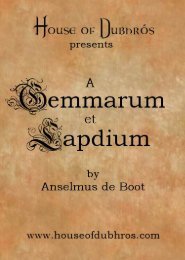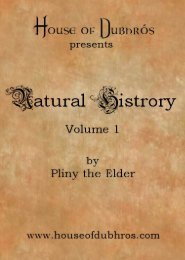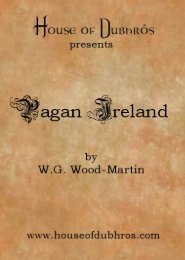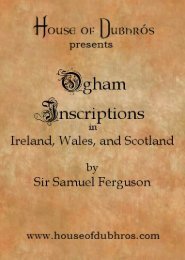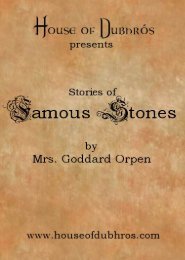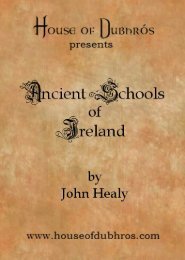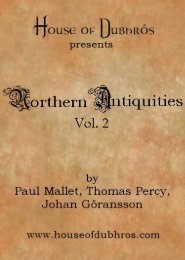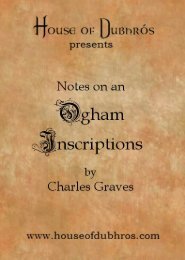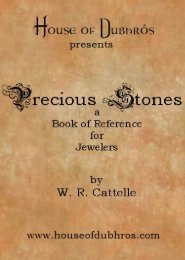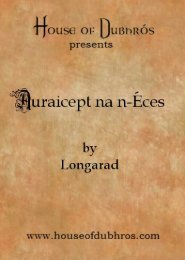Create successful ePaper yourself
Turn your PDF publications into a flip-book with our unique Google optimized e-Paper software.
22 The Anglo-Saxon Runic Poem<br />
81 JS&c bib <strong>of</strong>erheah. eldum dyre<br />
/<br />
sti]? on stabule, stede rihte hylt,<br />
Ceah him feohtan on firas monige.<br />
84 Yr byb eebelinga and eorla gehwaes<br />
wyn and wyrbmynd, byb on wicge fseger,<br />
fsestlic on faerelde, fyrdgeafewa sum.<br />
87 lar by]? eafia; and Seah a bruceb<br />
fodres on foldan, hafab faegerne eard<br />
wastre beworpen, tSser he wynnum le<strong>of</strong>ab.<br />
90 Ear byb egle eorla gehwylcun,<br />
$onn[e] fsestlice flsesc onginneb,<br />
hraw colian, hrusan ceosan<br />
blac to gebeddan ; bleda gedreosa]?,<br />
wynna gewita)>,<br />
wera geswicaj*.<br />
86. H. fyrdgeacewa. 87. H. eafixa. 88. H. onfaldan.<br />
91. ffonn. At the end <strong>of</strong> Hickes' transcript there stand four runes to<br />
which no verses are attached, cw, cweorS '; c [caZc]; st, stan; g, gar. Two<br />
<strong>of</strong> these Runic letters, calc and gar, are found on the Ruthwell Cross in the<br />
value <strong>of</strong> guttural c and g.<br />
81. JEsc, identical in form with A (*ansuz), the fourth letter <strong>of</strong> the<br />
order alphabet, since in the majority <strong>of</strong> cases original a became SB in AS.<br />
84. Yr (Salzb. yr). The Runic passages in Cynewulf give no assistance<br />
and the meaning is much disputed. The new edition <strong>of</strong> Grein's Sprachschatz<br />
translates "horn," I know not upon what evidence unless it be the<br />
parallel phraseology <strong>of</strong> Riddle xv. Others have identified it with the ON.<br />
yr, "bow," cf. p. 32; but this corresponds to AS. eoh, p. 16. Is it possible<br />
to connect AS. yr with the word sexe-yre in the Chronicle 1012 E, translated<br />
by Plummer "axe-head," "axe-iron"? We might compare Yr er...brotgjarnt<br />
jam in the Icelandic poem, p. 32.<br />
87. Hickes, lar (io) bi& eafixa, and ffeah abrucefi. Following Dom. A.<br />
ix. and Galba A. n., W. Grimm emends to lor.<br />
As it stands eafixa is a Gen. pi. with nothing on which to depend, and<br />
the addition <strong>of</strong> sum (Grein) would render the verse unmetrical. The final a<br />
<strong>of</strong> eafixa should therefore be deleted (Rieger).<br />
abrucep Grimm, a brucep, "always enjoys."<br />
This letter is not in the Salzburg Codex.<br />
No such word as iar, ior exists ; but the description here given is plainly<br />
that <strong>of</strong> some amphibious creature, usually taken as the eel (Grimm), though<br />
it might equally well be a lizard or newt (affexe, efe.te).<br />
It is worth remarking that the letter is used in a number <strong>of</strong> Scandinavian<br />
inscriptions from the seventh century onwards, e.g. Bjorketorp, Stent<strong>of</strong>te,<br />
Gommor (Blekinge) and Vatn (Norway), seventh cent. ; Kallerup, Snoldelev,<br />
Flemlose (Denmark) and Orja (Skaane), early ninth cent., as a form <strong>of</strong><br />
the letter dr (a). The original value <strong>of</strong> this was.?'; moreover it occurs in<br />
two English inscriptions : Dover, GISLHEARD ; Thornhill III, GILSUITH,<br />
with the value <strong>of</strong> palatal g, since palatal g and original j had fallen together<br />
at an early date in AS.



